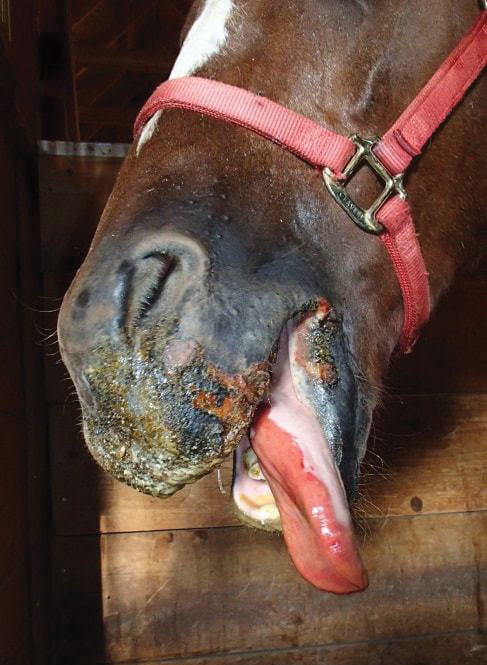
Vesicular stomatis is impacting equine owners in the Ozarks; the virus can spread to other livestock
Animal health officials in Missouri, Oklahoma and Arkansas are warning livestock owners to be on the lookout for vesicular stomatitis. Cases of the non-fatal but highly-contagious virus have been confirmed in all three states.
The U.S. Department of Agriculture states VSV is a viral disease which primarily affects horses, mules and donkeys, as well as cattle and swine. It can occasionally infect sheep and goats.
In affected livestock, VSV causes blister-like lesions in the mouth, on the dental pad, tongue, lips, nostrils, hooves and teats. Blisters will swell and break, leaving painful, raw tissue, resulting in animals refusing to eat and drink, and showing signs of lameness. Animals will typically suffer from severe weight loss.
VSV is not a new virus, but it is not annually reported. The largest and most recent outbreak was in 2015, according to the USDA. The virus was found in 823 infected premises in eight states (Arizona, Colorado, Nebraska, New Mexico, South Dakota, Texas, Utah and Wyoming).
Dr. Tim O’Neill of Country Vetrinary Clinic in Farmington, Ark., said there is no vaccine to prevent VSV.
Outbreaks usually occur during the warmer months, often along waterways. The time from exposure to the onset of clinical signs is two to eight days, according to a fact sheet from the USDA.
The current outbreak was first detected in the United States on April 13 and has since been identified on more than 300 premises in eight states.
Nine Missouri counties have been identified as confirmed positive or suspected premises, forcing quarantines of those properties until symptoms subside, which is usually two to three weeks.
The Oklahoma outbreak began on July 7, and nine counties have been affected, with 18 confirmed positive and four suspect premises.
Arkansas’ case count is smaller, with four confirmed locations and one suspected premise in the state.
“The premises will remain under quarantine until 14 days after the onset of lesions in the last affected animal on the premises and at least thirty days from the first verification of VSV infection on the premise,” O’Neill said, adding that this directive was passed down in July by Arkansas’ state vetrinarian. “Right now the only species that is under strict quarantine is equidae, which includes horses, donkeys, mules, zebras and miniatures.”
Arkansas has implemented some livestock travel restrictions in the wake of the virus. Owners of equine, cattle and other hooved animals in Arkansas preparing to transport animals should check with veterinary authorities regarding what, if any, certifications are required.
How is VSV transmitted?
Angela Pelzel-McCluskey, DVM, a national equine epidemiologist for the USDA’s Animal and Plant Health Inspection Service, Veterinary Services, has said VSV is transmitted by black flies, sand flies and biting midges, although other insect vectors may also harbor the virus. She recommends vector remediation, as well as the use of a pyrethrin-based fly repellent that’s labeled for use in animals.
Direct contact with lesions can cause the spread of VSV. Because the virus lives in the vesicles, horses are left with virus-filled, oozing lesions that eventually rupture and release virus. The virus is then easily transmitted when one horse contacts an infected horse’s open lesion. Animals suspected to be suffering from VSV should be quarantined.
VSV can be transmitted through indirect contact. Shared water troughs, feed buckets or other contaminated surfaces can be a source of virus transmission even after the affected animal has left the area.
Because the virus can spread to humans, it’s recommended producers practice good biosecurity by wearing gloves when handling lesioned animals, being careful to avoid having an animal with nose/muzzle/tongue lesions sneeze or cough in the producer’s face. Hands should be washed with soap and water, and clothing changed if producers come in contact with a lesioned animal.
O’Neill emphasized it is important to isolate and quarantine suspected animals.
Other Symptoms
In addition to the appearance of blisters or lesions, horses often exhibit excessive slobbering and sometimes exhibit a fever of 102 to 104 degrees, according to the USDA.
Horses can also develop mastitis (inflammation or infection of the mammary gland) if vesicles appear on their udders. This, however, is more commonly observed in cattle. Male horses with lesions on their sheath may have trouble urinating.
Treatment
There are no specific treatments for the viral infection itself, but experts say the virus, in most cases, clears on it own with just some supportive care.
“TLC and just rinse the mouth with antiseptic to cleanse the blisters and sores,” O’Neill said. “Feed a gruel to help with eating.”
Older horses, however, or those with underlying medical conditions might need more veterinary intervention.





